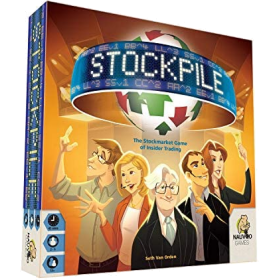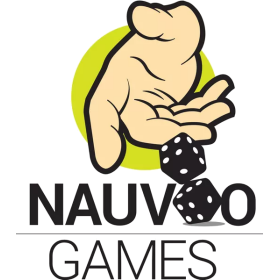stockpile
 Stockpile is an economic board game that combines the traditional stockholding strategy of buy low, sell high with several additional mechanisms to create a fast-paced, engaging and interactive experience.
Stockpile is an economic board game that combines the traditional stockholding strategy of buy low, sell high with several additional mechanisms to create a fast-paced, engaging and interactive experience.
In Stockpile, players act as stock market investors at the end of the 20th century hoping to strike it rich, and the investor with the most money at the end of the game is the winner. Stockpile centers on the idea that nobody knows everything about the stock market, but everyone does know something. In the game, this philosophy manifests in two ways: insider information and the stockpile.
First, players are given insider information each round. This information dictates how a stock’s value will change at the end of the round. By privately learning if a stock is going to move up or down, each player has a chance to act ahead of the market by buying or selling at the right time.
Second, players purchase their stocks by bidding on piles of cards called stockpiles. These stockpiles will contain a mixture of face-up and face-down cards placed by other players in the game. In this way, nobody will know all of the cards in the stockpiles. Not all cards are good either. Trading fees can poison the piles by making players pay more than they bid. By putting stocks and other cards up for auction, Stockpile catalyzes player interaction, especially when potential profits from insider information are on the line.
Both of these mechanisms are combined with some stock market elements to make players consider multiple factors when selling a stock. Do you hold onto a stock in hopes of catching a lucrative stock split or do you sell now to avoid the potential company bankruptcy? Can you hold onto your stock until the end of the game to become the majority shareholder, or do you need the liquidity of cash now for future bidding? Do you risk it all by investing heavily into one company, or do you mitigate your risk by diversifying your portfolio?
In the end, everyone knows something about the stock market, so it all comes down to strategy execution. Will you be able to navigate the movements of the stock market with certainty? Or will your investments go under from poor predictions?
Niver a c'hoarierien: 2 - 5
Padelezh ar bartienn: 46 mn
Kemplezhded : 2 / 5
C'hoari da stockpile pe da 1194 c'hoari all enlinenn.
Pellgargañ ret ebet - c'hoariit war-eeun adalek ho merdeer.
Gant ho mignoned ha miliadoù c'hoarierien/ezed en hollved.
Evit netra.

C'hoari da stockpile pe da 1194 c'hoari all enlinenn.
Pellgargañ ret ebet - c'hoariit war-eeun adalek ho merdeer.
Gant ho mignoned ha miliadoù c'hoarierien/ezed en hollved.
Evit netra.

Diverradenn ar reolennoù
Overview
Stockpile is a fast-paced economic game of corporate investments, insider trading, and market manipulation. Each player acts as a private investor with the goal of amassing the greatest net worth. The player with the most money at the end of the game wins.
Playing The Game
Stockpile is played over 5-7 rounds, depending on the number of players. Each round consists of six phases:
- Information Phase
- Supply Phase
- Demand Phase
- Action Phase
- Selling Phase
- Movement Phase
During each phase, play begins with the player with the First Player Token and continues clockwise.
Information Phase
During the Information Phase, each player receives insider information in the form of a Company Card and a Forecast Card. Each player should look at their Company and Forecast Cards and keep them hidden from other players. The two cards are paired together to indicate a future change to a particular company's stock value. The actual change of the stock value takes place at the end of the round during the Movement Phase.
One pair of Company and Forecast Cards is public information (No public pairs exist in a 2P game). Both pairs of cards (the insider information and public information) should be used to make decisions during the Demand Phase and Selling Phase.
All 6 company's stock values will be impacted every round by a Forecast Card.
In the base game, the 6 Forecast Cards are all different. The Forecast Cards include: -3, -2, $$, +1, +2, +4. These values are also listed on the Player Board.
Supply Phase
One card is placed from the Market Deck face-up onto each Stockpile. These cards could be shares of company stock, trading fees, or action cards.
Each player is dealt two cards from the Market Deck.
In turn order, each player places one card face-up and one card facedown on the Stockpile(s) of their choice.
Demand Phase
Players take turns bidding on Stockpiles until each Stockpile has only one Bidding Meeple on it.
Players pay their bids, collect all cards, and pay any trading fees. Trading fees range between $1,000 - $3,000.
Stock cards are kept hidden in a player's stock portfolio.
Action Phase
In turn order, players use all Action Cards acquired during the Demand Phase. Action Cards may move a stock's value by +2 or -2.
Selling Phase
In turn order, players may sell any number of stocks that they own and receive money from the supply equal to their current value. When selling a split stock, you may choose to sell one or both of its shares.
Movement Phase
All pairs of Company Cards and Forecast Cards are revealed and the stock values move accordingly, taking into account stock splits and bankruptcy.
- Stock Split - If a stock’s value ever increases to more than 10, the stock splits. A stock split effectively doubles your existing shares for that stock. When a stock splits, all players who have stock of that type in their portfolio will reveal it and move it to their Split Portfolio face-down. If the increase causes the stock’s value to land exactly on the Stock Split space, then the value of the stock returns to 6. If the stock’s increase would move the value further than the Stock Split space, reset the value of the stock to 6 and continue to increase the stock’s value.
- IMPORTANT: Any new stock obtained after the stock split goes in a player’s regular Stock Portfolio, not the Split Portfolio. If a player already owns a stock in his Split Portfolio and that stock splits again later in the game, then that player receives $10,000 in Currency Cards for each Stock Card of that type in their Split Portfolio. The stock then remains in the Split Portfolio.
- Bankruptcy - If a stock’s value ever moves below 1 on a turn, it immediately goes bankrupt. All players discard all stock of that kind that they own, including any stocks in their Split Portfolio. Return the stock’s price to the starting value of 5.
The Forecast Cards with $$ indicates a $2,000 dividend for each share that a player owns and elects to show.
Round End
Advance the Round Marker and pass the First Player Token clockwise to the next player.
Game End
At the end of the game, players will reveal all of the stock cards in their portfolio and perform the following steps:
- Determine majority shareholders. A majority shareholder is the player with the most stock in any company. The majority shareholders of each company receive a bonus of $10,000. If there is a tie, all tied players receive $5,000. Reminder: Shares in player’s Split Portfolios count as double when determining majority shareholders.
- Sell all stock at final values. Each player then sells their shares to the bank at a price equal to the final value of the stock. Reminder: Any shares in players’ Split Portfolios count as double.
- Total each player’s currency. Add up each player’s money, including any Currency Cards on hand.
The player(s) with the most money wins.
2P Variant
It's suggested to play Stockpile at least once with more than two players before trying the 2-Player Variant. The 2-player variant plays similar to a 4-player game. However, there a few changes to the round’s phases. These can be round in the rules here: https://boardgamearena.com/gamepanel?game=stockpile

